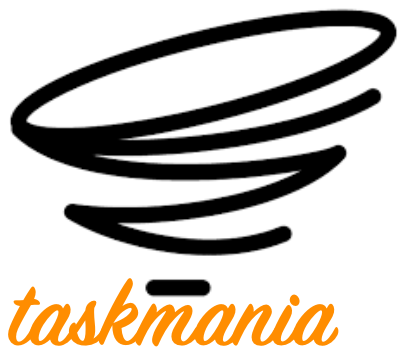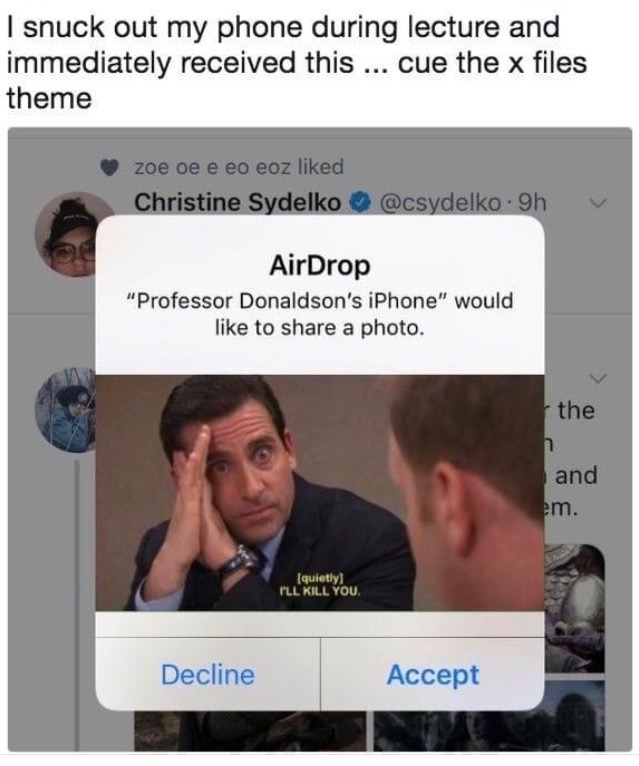
For Assignment Three I’ve “created” an app that allows teachers to make quick and private interjections when students are off task on their phones during instructional time. In the following episode of Edumacation, the “host” Eric* and I discuss the need for such a product, the potential pitfalls, and exactly how it works.

(via Instagram)
Here’s an annotated bibliography of the key points cited during the interview:
Near Unanimity on the Necessity of Action.
Montgomery, M. (2019, November 05). Ontario classrooms: Mobile phone ban now in effect. Retrieved July 15, 2020, from https://www.rcinet.ca/en/2019/11/05/ontario-classrooms-mobile-phone-ban-now-in-effect/
Finding agreement among all the stakeholders in a particular issue is exceedingly rare, but the issue of mobile devices in classrooms has managed to bring about such agreement. “The government says during consultations about the idea in 2018, there was close to unanimity from teachers, parents and even students that the devices should be restricted in some way” (Montgomery, 2019).
Bring Your Own Device.
BYOD. Clarity Innovations. (2020). Retrieved July 15, 2020, from https://www.k12blueprint.com/toolkits/byod
Nearly every student in schools today has a super computer in their pockets that’s worth to the tune of $1,000. It’s almost nonsensical for school districts to be spending their continually dwindling budgets on tablets for student use when the vast majority of kids are already so incredibly well equipped. BYOD is seen as “a way of increasing access to technology without the cost of purchasing a device for each student” (Clarity Innovations, 2020).
Cell Phone Use in Classrooms.
Cell Phone Ban in Classrooms. Ontario Principals’ Council. (2019, March 12). Retrieved July 15, 2020, from https://www.principals.ca/en/who-we-are/resources/Documents/Cell-Phone-Ban-in-Classrooms-Mar-12.pdf
“According to stats Canada nearly 100% of youth use the internet on a daily basis and own a smartphone”, so it seems prudent to take advantage of that incredible technological firepower.
Cell Phones Diminishing Cognition.
Bergland, C. (2017, June 25). Are Smartphones Making Us Stupid? Retrieved July 15, 2020, from https://www.psychologytoday.com/ca/blog/the-athletes-way/201706/are-smartphones-making-us-stupid
“Cognitive capacity and overall brain power are significantly reduced when your smartphone is within glancing distance—even if it’s turned off and face down—according to a recent study. This new report from the University of Texas at Austin” (Bergland, 2017). Literally being able to see it – even if you’re not using it – can occupy a tiny part of your brain with simply not touching the thing.
Positive Punishment in Classrooms.
Ackerman, C. (2020, April 16). 12 Examples of Positive Punishment & Negative Reinforcement. Retrieved July 15, 2020, from https://positivepsychology.com/positive-punishment/
A simple emoji popping up on a screen is, technically speaking, an example of a positive punishment. The word punishment seems harsh – out of place even. But the definition of positive punishment being when “something is ‘added’ to the mix that makes the behavior less likely to continue or reoccur” (Ackerman, 2020) tracks quite well with the purpose of the app in question.
Images: PNG All. Twister PNG Transparent Images. Twister PNG HD. Retrieved July 16, 2020, from http://www.pngall.com/twister-png
* Eric is an actor friend of mine. I wrote the scripts for each of us and he deftly read his lines.
Hi Tyler,
Did you do it all by yourself with changed voices? Interesting name for this application and I had fun listening to your podcast! I do agree with James that it would be nice to have a full transcript for reference sake or for further studies. Actually I hope that more podcasters could offer transcripts for ELL learners.
It caught my attention when I first read your brief introduction of the App. I believe it is a headache for many teachers when they try to keep students on task when using cellphones and other electronic devices.
The idea of having the App empowers teachers during the class sounds tempting, however, I’m concerned that doesn’t help the students to build up their own self-discipline ability. Adrian’s A3 “Has school taken too much control” (https://blogs.ubc.ca/etec523/2020/07/31/a3-has-school-taken-too-much-control/#comment-2591) expressed the concerned of the teachers and schools taking too much control over students by using apps like these. Also I’m concerned that would this interrupt the flow of the class when teachers have to check on their device to and stop to send alerts. Maybe we could have students install an App like this on students phones, and got their consent of having an App operates on their phones for a certain time and help them concentrate. That way the students are voluntarily using a tool to help them stay on task.
Thanks for engaging, Jane. The app would be installed by students on their own phones. It wouldn’t be entirely voluntary, but rather compulsory. I don’t think it would disrupt the flow of class work – it would only disrupt the flow of students off task. The app would be for times when the students are engaged in their own work and meant to be using their phones for research and educational purposes. It wouldn’t be for times when there’s a lesson or a lecture taking place. I hope that answers your concerns.
Tyler, I really enjoyed your podcast introduction to Taskmania. Your reenactment was entertaining, engaging and informative. It felt natural and, with slightly better mics and some shameless Squarespace ads, it would be of similar calibre to “This Week in Tech” or “The Accidental Tech Podcast.” Compliments to Eric as a well – he’s a convincing host.
I especially liked you how you brought home the idea that helping students effectively manage and utilize cellphones in the classroom is a valuable life-skill for all students to learn.
I see applications for this app in both secondary and post-secondary education – and maybe even in the boardroom or faculty meetings. Perhaps combined with Aiann Oishi’s FirstYearU, mobile time-blocking app, the student’s phone could automatically remind the student to stay on task. I can also see it as a plugin or extension to Zoom or Blackboard Collaborate. The instructor could quietly nudge a student during their virtual lectures.
I agree with James Seaton that a bit more functionality would be nice, (such as positive messaging to students who appreciate a pat on the back but not in front of the class) but I can’t entirely agree with James’ assessment that your discussion of Taskmania suggests a “my way or the highway approach.” I saw your podcast as a discussion/review of a potentially useful tool and not a pitch by a principal to parents. Eric asked for your perspective and you provided your thoughts on a way forward. I appreciated your efforts to discuss the obvious obstacles and possible sources of opposition.
Your annotated bibliography was a nice touch as well. It brought everything together in context and resembled the “show notes” you see on the home pages of the top podcasts.
Well done Tyler!
Thanks, Jamie. I used the pinhole mic on my old iMac, so any mics would be an improvement! And I like your ideas of a nudge during a Zoom lecture and of a pat on the back function; something nice instead of only “punishment” – that’s a great call.
I’m glad you got the idea of the podcast too – that it wasn’t a pitch to stakeholders, but a frank discussion around the product. There’s a clear distinction between the two, of course.
As ever, thanks for engaging!
Hi Tyler,
First off, I have to say that I quite enjoyed the format for your presentation. I think it can be a bit of a gamble to rely solely on audio (aside from the included annotated bibliography), but you managed to make it very engaging. That said, I think it would have been nice to include a full transcript of the podcast for reference sake. I’d love to be able to search text for a specific point and reread some of the sections, but instead I’ve had to listen back through some sections multiple times. Even now, I’m not sure if you ever described the exclamation mark function on the app and how it differs from the question mark or “inquiry” function. Also, the way that you prefaced the issue that your app would be addressing was also well done. It flowed very naturally in the conversation and didn’t make it feel like you were following a rigid structure to the presentation.
Being a bit more critical, I would love to know if there’s any functionality beyond essentially air dropping messages to particular students. Is there any way to confirm that students are actually on task via the app? Maybe I missed something, but it seemed like the app was possibly a bit too simple and could have included more functionality. Also, I did find the attitude towards parental concerns a little bit dismissive (especially calling privacy concerns “idoitic”). I think buy-in for an app like this might be tricky, so I’d wished you spent more time talking about warming reluctant parents up to the idea rather than taking what felt like a “my way or the highway” approach.
Anyways, I enjoyed your assignment and it’s given me plenty of food for thought – thanks!